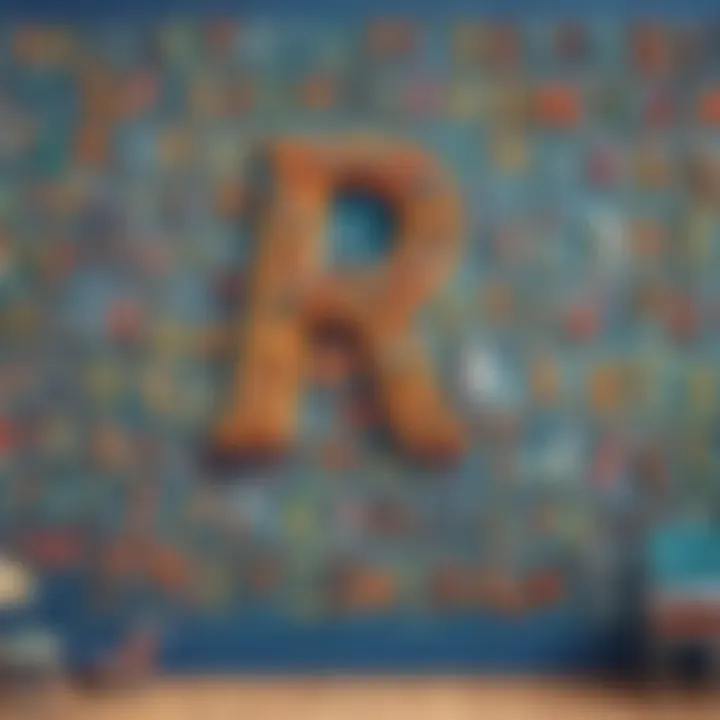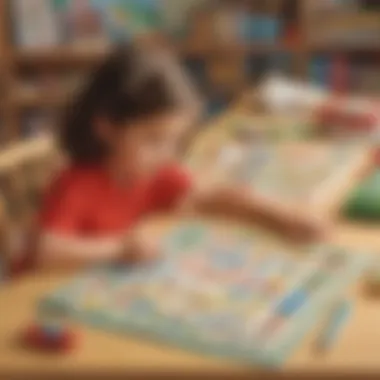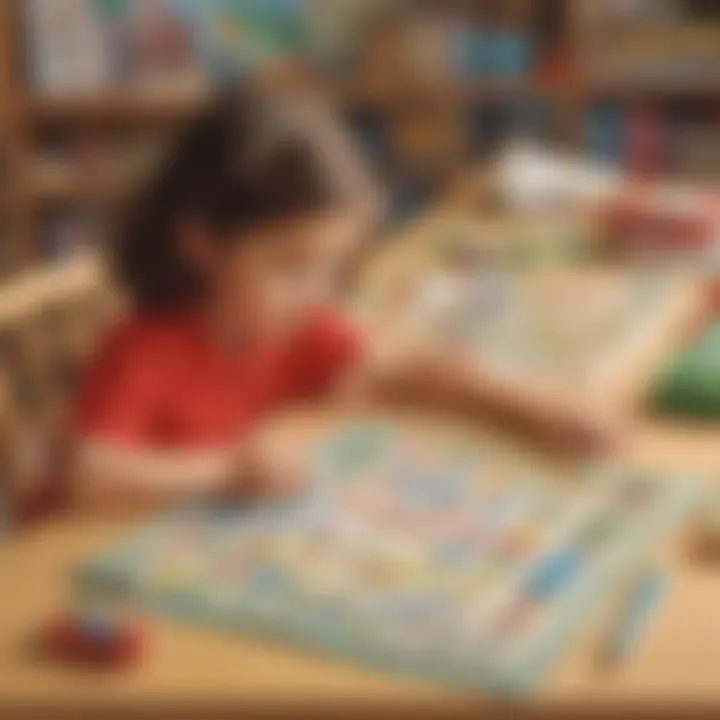Engaging Ways to Teach the Alphabet to Kids


Intro
Learning the alphabet forms the essential groundwork for literacy development in young children. As they progress through initial schooling, familiarity with letters is crucial not just for reading but also for effective communication. Therefore, innovative approaches are needed to engage children effectively and cater to diverse learning styles. This article delves into various creative techniques, activities, and methods that can transform the typically mundane process of alphabet learning into an enjoyable experience. By employing diverse strategies, parents and educators can enhance children's understanding of letters, making the journey memorable and impactful.
Creative Activities
Engaging children through hands-on activities is one of the most effective methods for teaching the alphabet. Creative activities help bridge the gap between theory and practice, making learning more tangible. Here are some compelling suggestions:
Craft Ideas
- Letter Collage: Children can cut out letters from magazines and newspapers to create their custom collages. This reinforces letter recognition while allowing them to explore their creativity.
- Alphabet Banners: Using colored paper, children can create banners featuring each letter. They can hang these banners in their room, which helps reinforce letter familiarity.
- Memory Matching Game: Parents can craft letter cards for a fun memory game. Each letter has a matching image that starts with that letter, enhancing both recognition and vocabulary.
Step-by-Step Guides
To implement these craft ideas, clear instructions are essential. For example, in the Letter Collage activity:
- Gather a variety of magazines and newspapers.
- Prepare a large sheet of paper to serve as the base.
- Encourage children to search for and cut letters of their choice.
- Have them glue the letters onto the base sheet in a creative layout.
This step-by-step guidance fosters independence and problem-solving skills in children.
Educational Value
Participating in creative activities helps children memorize letters more effectively. The tactile aspects of crafts engage different parts of the brain, and therefore, improve retention. Moreover, children develop fine motor skills, boosting their overall learning experience alongside letter recognition.
Fun Quizzes
Quizzes present an entertaining way to assess and reinforce what children have learned. Using platforms like ElemFun can make this process seamless.
Quiz Topics
The quizzes can cover various topics such as:
- Recognizing uppercase and lowercase letters.
- Identifying letter sounds.
- Matching letters with corresponding images.
Question Types
A variety of question types can elevate children's engagement:
- Multiple choice questions can reinforce knowledge.
- Fill-in-the-blanks activities encourage active recall.
- True or false statements provide a quick assessment of understanding.
Knowledge Reinforcement
These quizzes serve not only as assessment tools but also reinforce learning. Immediate feedback helps children understand their progress and areas where they may need improvement. This constant reinforcement anchors their knowledge of the alphabet.
Fact-Based Articles
Articles offer valuable information presented in an accessible manner. They can supplement learning with facts and insights related to the alphabet experience.
Topics
These articles may cover diverse topics such as:
- The history of the alphabet.
- The significance of phonics in early literacy.
- Innovative teaching techniques available today.
Engaging Content
This content is usually structured with clear headings and bullet points, making it easy for children to read and comprehend. Inclusion of visuals further enhances the learning experience.
Prelims to Alphabet Learning Techniques
Learning the alphabet is a foundational skill for all children. It is not only a stepping stone to reading and writing, but also an essential component of communication. An understanding of the alphabet allows kids to decode words and express their thoughts effectively. Mastery of these letters builds confidence and sets the groundwork for future academic success.
The introduction of various learning techniques can significantly enhance the learning experience when it comes to the alphabet. Engaging with the letters through diverse methods helps children retain what they learn more efficiently. Techniques ranging from traditional methods to more creative approaches cater to different needs, making the study of the alphabet more accessible to all.
Another key aspect to consider is the age of the learners and their cognitive development stage. Young children often learn better through play and hands-on experiences. Therefore, it is crucial to integrate fun and interactive activities that align with their natural learning styles. The benefits are multifaceted: children are more motivated to learn, retain information longer, and develop a love for learning.
Ultimately, by exploring innovative techniques for teaching the alphabet, educators and parents can provide children with enriching opportunities that go beyond rote memorization. This not only fosters a deeper understanding of letters but also encourages a lifelong appreciation for language and literacy.
Importance of Learning the Alphabet
The significance of learning the alphabet cannot be overstated. It builds the foundation for literacy skills. When children learn the alphabet, they are equipped with the ability to sound out words, which is essential for reading. The connection between letters and sounds is a critical component of phonemic awareness, a vital skill in early education.
In addition to its role in literacy, mastering the alphabet aids cognitive development. Children learn classification skills by recognizing letters and understanding their categorization as separate entities. This can enhance their ability to form connections between letters, sounds, and words, shaping their comprehension in language.
Moreover, learning the alphabet has social ramifications. It enables children to communicate and interact more effectively with their peers. When children can express themselves clearly, they develop confidence and creativity in their speech. This confidence can transfer to other areas of life, impacting their overall self-esteem.
Recognizing Different Learning Styles
Understanding that each child has a unique learning style is crucial in the process of alphabet learning. Some children are visual learners; they may benefit from seeing letters in various formats such as colorful charts or flashcards. Engaging visuals can captivate their attention while helping them memorize the shapes and sounds of letters.
On the other hand, auditory learners often absorb information better when it is spoken aloud. For these children, singing alphabet songs or engaging in letter chants can be effective ways to help them internalize letter names and their corresponding sounds.
Kinesthetic learners acquire knowledge through movement. These children may struggle with traditional methods like reading or writing. They thrive in active environments where they can physically interact with learning materials. Activities like letter scavenger hunts or crafting letters with playdough serve to engage them in a meaningful way. Recognizing and adapting to these learning styles can make the process of learning the alphabet a more personalized and effective experience.
"A child learns best when they are involved, engaged, and having fun."
Interactive Games for Alphabet Mastery
Interactive games play a critical role in making the process of learning the alphabet both engaging and effective. Young learners have natural curiosity, and incorporating play into their education allows them to explore letters dynamically. Through interactive games, children can develop their cognitive skills while improving their alphabet knowledge. These games can enhance memory, promote problem-solving, and encourage social interaction. Moreover, when children learn through play, they often exhibit higher retention rates compared to traditional methods. It creates an environment where learning feels less like a chore and more like an adventure.


Alphabet Scavenger Hunts
Alphabet scavenger hunts are an excellent way for children to discover letters in their environment. This activity encourages exploration and observation skills, which are essential for young learners. To set up a scavenger hunt, parents or educators can create a list of items starting with different letters of the alphabet. For example, children might search for an apple, a book, or a toy. This experience fosters curiosity and excitement while reinforcing letter recognition.
Children can work individually or in teams, increasing the opportunity for social interaction. During the scavenger hunt, discussions about the letters and items can occur, further enhancing learning. It offers flexibility in addressing the needs of different learners. As children find objects, they can also practice writing or saying the letters, combining physical activity with language skills.
Letter Bingo
Letter Bingo serves as another interactive game that helps reinforce alphabet learning. In this game, each child receives a card with letters distributed randomly. An adult calls out letters, and children must mark them on their cards. The first child to form a predetermined pattern, like a line or full house, wins.
This game promotes engagement among children, as they remain attentive and focused. It can also adapt to various learning preferences, adjustable in complexity based on the age group involved. For instance, younger children can play with single letters, while older ones might match the letter to a word or image.
Utilizing Letter Bingo not only reinforces letter recognition but also sharpens listening skills. Additionally, educators can introduce variations of the game, using sounds associated with letters, enriching the learning experience.
Learning through play enhances retention and makes the alphabet more memorable.
Hands-On Activities to Reinforce Learning
Hands-on activities play a critical role in reinforcing alphabet learning. They engage young learners in a tactile and memorable way. This approach allows children to actively involve themselves in the learning process. Rather than passively absorbing information, they manipulate materials to form letters. Thus, the hands-on method caters to various learning styles, making it effective for diverse classrooms.
These activities promote kinesthetic learning, which is particularly beneficial for young children. Through direct interaction with materials, children can improve their fine motor skills. This builds not only their letter recognition but also their confidence in using the alphabet. Engaging with letters through hands-on methods also allows for creativity and problem-solving, essential skills in a child’s education.
Crafting Letters with Playdough
Crafting letters with playdough offers a stimulating way to introduce the alphabet to children. Playdough is versatile and fun, enabling children to shape letters with their hands. This hands-on activity allows for exploration of both uppercase and lowercase letters. Children can squeeze, roll, and flatten the playdough to create different letter forms. This tactile experience helps solidify their understanding of letter shapes.
Parents and educators can enhance this activity by incorporating vocabulary. For instance, once children mold a letter, they can think of words that start with that letter. This connection strengthens their phonetic awareness alongside the physical shaping of the letters. Moreover, when children create words or their names, it adds a personal touch. This makes learning more relevant and exciting for them.
Alphabet Art Projects
Alphabet art projects allow children to express creativity while reinforcing letter learning. These projects can take various forms, such as collages, paintings, or drawings. Children can use various materials to represent letters artistically. For example, they can cut out pictures from magazines that start with a certain letter. This brings letters to life in a unique way.
Collaboration is another benefit of alphabet art projects. When children work together, they can share ideas and strategies. This peer interaction enhances their learning experience. Also, these projects can be easily adapted for different environments, whether at home or in a classroom.
Here are some ideas for alphabet art projects:
- Letter Collages: Gather items that begin with a specific letter and assemble them on a poster.
- Painted Letters: Use brushes and paints to create colorful letter designs.
- Nature Alphabet: Collect natural items, like leaves or stones, and arrange them into letter shapes.
Such projects foster a deeper understanding of the alphabet, transforming the learning process into an enjoyable, memorable experience.
Technology-Driven Methods for Alphabet Learning
The world is increasingly digital, and the incorporation of technology in education has transformed the ways children learn. In the context of learning the alphabet, technology-driven methods provide valuable resources that make learning engaging and accessible. These approaches offer unique benefits such as customization, interactivity, and immediate feedback, which can cater to diverse learning styles. Integrating technology into alphabet learning can enrich traditional methods and foster a love for letters among young learners.
Educational Apps for Mobile Learning
Educational apps have become essential tools for teaching the alphabet. These apps are designed to create an engaging learning experience through interactive games and activities. They usually present letters in a fun manner, allowing children to explore their shapes and sounds through touch-based interactions.
Some notable benefits of these apps include:
- Accessibility: They can be accessed on various devices, making learning available anywhere at any time.
- Customization: Many apps allow parents to customize the learning experience according to the child's pace and style.
- Engagement: Vibrant graphics and interactive features capture the child's attention, making learning fun.
When selecting an educational app, consider the following:
- Look for apps that are age-appropriate and align with educational standards.
- Check user reviews to assess effectiveness and user satisfaction.
- Ensure the app provides avenues for tracking progress, enabling parents to see advancements over time.
Interactive Online Worksheets
Another innovative technology-driven method is the use of interactive online worksheets. These worksheets can be dynamic and encourage children to interact with letters through various exercises. They often incorporate drag-and-drop features, games, and quizzes that keep children engaged while reinforcing their understanding of the alphabet.
Benefits of interactive online worksheets include:
- Immediate Feedback: Children receive instant responses, helping them understand mistakes right away.
- Variety of Activities: Worksheets can include a mix of puzzles, matching games, and coloring activities that cater to different interests.
- Motivation: Completing online tasks can provide a sense of achievement, which motivates children to continue learning.
When implementing online worksheets, ensure they are visually appealing and user-friendly to maintain children's interest.
"Interactive learning tools can drastically transform the alphabet learning experience for children, making education more appealing and effective."
In summary, technology-driven methods for alphabet learning bring educational experiences to a new level. By utilizing educational apps and interactive online worksheets, parents and educators can provide children with the tools needed to master the alphabet effectively. The integration of technology in these methods offers the potential for a memorable and engaging learning journey.
Storytelling as a Learning Tool
Storytelling represents a powerful method for teaching the alphabet and developing literacy skills in young children. It actively engages their imagination, helps improve their vocabulary, and provides context for letter recognition and usage. When children hear stories, they connect letters with sounds and meanings, which helps them grasp the foundational concepts of reading and writing.
Incorporating storytelling in alphabet learning allows for a holistic educational approach. It builds a strong emotional connection to letters and words. Children are more likely to remember the letters associated with characters or elements in a story, which can be more impactful than rote memorization alone. Moreover, storytelling promotes active participation, as children can interact with the narrative through questions or drawing connections to their own experiences.
Alphabet Books for Young Readers
Alphabet books serve as an essential resource for young readers. These books often pair each letter with engaging illustrations and relatable words. For example, a book may depict an "A" for "apple" along with a vibrant picture of the fruit. This visual connection reinforces the relationship between letters and their corresponding sounds.
Additionally, alphabet books frequently incorporate rhythm and repetition, enhancing the learning process. Children enjoy the musicality in stories, and it makes learning feel like a fun activity rather than a chore. Educators can choose books that align with children’s interests, fostering a greater enthusiasm for letters.
Some recommended alphabet books include:
- Chicka Chicka Boom Boom by Bill Martin Jr. and John Archambault
- A is for Apple by A. E. Ali
- Alphabet City by Stephen T. Johnson
These titles utilize vibrant images and creative narratives, which are important for young learners. They also offer opportunities for interaction, such as asking questions about the pictures or what happens next in the story, further cementing the letters in the child’s mind.
Creating Personalized Stories with Letters
Creating personalized stories is another innovative way to enhance alphabet learning. By incorporating a child's name and favorite activities into a narrative, they become the protagonist of their learning journey. This personalization fosters a deeper investment in the material.


Parents and educators can guide children to craft their stories by providing sentence starters or prompts. For instance, if a child’s name is Mia, the story can start with, "M is for Mia, who loves to ride her bike." This technique not only reinforces letter recognition but also boosts creativity.
Personalizing stories with letters allows children to see themselves within the learning experience, making it more relevant and memorable.
Furthermore, these stories can be illustrated, turning them into a keepsake that a child can look back on. Each letter becomes a part of their personal narrative, bridging the gap between learning and personal expression. Each word written contributes to their understanding of letters and how they form meaningful expressions.
Music and Movement in Alphabet Learning
Learning the alphabet does not have to be a tedious process. Incorporating music and movement into alphabet learning can create a vibrant and dynamic atmosphere. This approach leverages natural rhythms and physical activity, which can enhance memory retention for young learners. Children often connect music with positive experiences, making it easier to remember letters and their corresponding sounds. Engaging kids through song can make the learning process more joyful and less isolating. Moreover, movement helps to activate different parts of the brain, promoting cognitive development. Over time, this can translate into a greater enjoyment of learning and improved alphabet recognition.
Alphabet Songs and Chants
Alphabet songs are a popular method used in classrooms and homes alike. These songs simplify the learning process by associating letters with fun tunes, making it easier for children to remember the order of the alphabet. For example, the traditional “ABC Song” has been a staple for generations. However, there are many variations that can add an exciting twist; some incorporate different languages or accents to promote diversity in learning.
Here are some benefits of using alphabet songs:
- Engagement: Songs naturally encourage participation. Children are likely to sing along and thus actively engage in the learning process.
- Memory Aid: The melodic structure helps to reinforce memory retention. Children remember songs better than straightforward facts.
- Rhythmic Patterns: The rhythm can help children with pronunciation as they frequently revisit the sounds in a musical context.
To implement this, parents and teachers can:
- Create their own songs or chants with different letter sounds.
- Use popular songs and modify the lyrics to include the alphabet.
- Encourage movement by creating actions that go along with the letters in the songs.
Movement Games Incorporating Letters
Integrating movement games is another effective strategy for teaching the alphabet. These activities not only teach letters but also promote physical fitness. Combining physical activity with learning makes the experience more enjoyable, as children often prefer kinetic interaction. Movement games can include:
- Letter Jump: Place letters or letter cards on the ground and have children jump from one letter to another as they call out the names.
- Alphabet Dance: Associate a specific dance move with each letter, creating a dynamic way to associate letters with actions.
- Letter Relay: Organize a relay race where children have to collect letters and bring them back to spell a word.
By incorporating games with movement, children are likely to develop a stronger connection with the alphabet. They become more physically active while learning, which benefits their overall well-being. Additionally, these activities can pave the way for collaborative learning experiences, encouraging social skills while they play and learn together.
"Learning the alphabet through music and movement promotes an engaging and interactive classroom experience, significantly enhancing children's retention and enjoyment of literacy education."
Using Visual Aids for Effective Learning
Using visual aids plays a crucial role in helping children grasp the concepts of the alphabet. Visual tools can reinforce learning by providing context and enhancing memory retention through association. This approach recognizes that many young learners are visual processors, making visual stimulation a vital component of their educational experience. When children see letters represented in various formats, they create mental connections that facilitate better understanding.
Incorporating visual aids into alphabet learning has numerous benefits. Firstly, these aids can make the learning process more engaging. Children are often more motivated to learn when the material is visually appealing. Secondly, visual aids cater to different learning styles, accommodating those who thrive with images and diagrams. This method not only aids comprehension but also supports long-term retention of the alphabet. Moreover, visual learning fosters a sense of accomplishment. When children can recognize letters and associate them with images, they develop confidence in their skills.
While using visual aids, it is essential to consider how they align with the overall learning objectives. Effective implementation requires selecting high-quality materials that are age-appropriate. Consideration must also be given to the variety of visual tools—ranging from simple flashcards to elaborate educational charts. Such diversity can cater to unique learning preferences and maintain students' interest over time. Managing the visual environment thoughtfully can enhance focus and improve the overall learning experience.
Flashcards and Posters
Flashcards serve as an effective tool to aid in alphabet learning. They can be used in various ways, from memorization practices to interactive games. Children can compete against each other to match letters with their corresponding images, enhancing both recognition and recall. Flashcards promote active participation, making learning a dynamic experience.
Benefits of Flashcards:
- Promotes active learning: Children engage directly with the material.
- Adaptable: Flashcards can be used both in group settings and during one-on-one tutoring sessions.
- Versatile: They can support various activities, such as quizzing or matching games, suitable at home or in classrooms.
Similarly, posters displaying the alphabet can transform walls into vibrant learning environments. Alphabet posters not only provide a constant visual reminder of letters but also depict them in various contexts. Seeing the alphabet in different fonts and styles can spark children’s curiosity, enhancing their understanding of how letters are used in daily life.
Alphabet Charts and Diagrams
Alphabet charts are another valuable visual aid that offers a structured overview. These large displays highlight each letter prominently and can include images or words that start with each letter. They encourage children to associate letters with recognizable objects, solidifying their learning. Moreover, teachers can utilize charts in a communal setting, prompting discussions about each letter’s significance.
The advantages of Alphabet Charts:
- Create a shared learning experience: They are suitable for group discussions and encourage collaboration.
- Visual reinforcement: Charts can support other activities by providing a reference point for students.
Incorporating diagrams of the alphabet can also enhance cognitive development. These diagrams may illustrate letter formation, helping children understand how to write each letter correctly.
Through the combination of various visual aids, such as flashcards, posters, charts, and diagrams, educators can create a rich and engaging environment that nurtures learning. Visual aids serve not only as teaching tools but also as motivators that turn abstract concepts into tangible learning experiences.
In a visually enriched learning environment, children are more likely to develop lasting literacy skills that will support their future educational journeys.
By effectively integrating these visual tools into standard curricula, parents and educators can significantly enhance children's familiarity with the alphabet, laying a solid foundation for literacy.
Exploring the Alphabet Through Nature
Exploring the alphabet through nature presents a unique approach to learning that combines education with discovery. Nature provides a rich learning environment that is appealing to young learners. Engaging with the outdoors fosters curiosity and exploration, which can deepen children's understanding of letters. This method aligns well with different learning styles, especially kinesthetic and visual learners. Children often find joy in discovering letters and words in their environment. In addition, outdoor activities can increase physical activity and enhance mood, creating a conducive atmosphere for learning.
Nature Walks to Find Letters
Nature walks can be an effective way to incorporate alphabet learning into daily activities. As children walk outside, they can look for natural objects that resemble letters. For example, a branch may look like a "Y" or a curved leaf could represent the letter "C." This approach not only reinforces letter recognition but also strengthens observational skills.
Parents or teachers can create a scavenger hunt list with letters of the alphabet. Children can check off items as they find them. This not only makes learning fun but also makes the letter shapes memorable. This practice can be enriched by discussing each letter’s shape or sound when they find corresponding objects.
Creating an Alphabet Garden
Creating an alphabet garden adds another layer of creativity to learning the letters. This hands-on project allows children to plant flowers, vegetables, or herbs that correspond with each letter. For instance, a garden could have sunflowers for "S" and tomatoes for "T." Engaging in gardening fosters patience and responsibility as children care for their plants.
Families can work together to design a layout for the garden where each letter has its section. This turns learning into a tangible experience. While working, parents can use this as an opportunity to discuss the letters, their sounds, and the names of the plants. Such an engaging method lays a strong foundation for alphabet mastery.
This method of learning offers children a multi-sensory experience that enhances retention and connection to letters.
Parental Involvement in Alphabet Learning
Parental involvement plays a crucial role in the process of learning the alphabet. When parents take an active part in their child's education, they help create a positive learning environment. This involvement can significantly enhance a child's understanding and retention of letters. Furthermore, it builds a strong foundation for reading and writing skills, which are essential for academic success.
Parents can support their children by recognizing the unique learning styles of each child. By catering to these styles, parents can tailor their approaches to make learning effective and enjoyable. Not only does this foster a love for letters, but it also engages the child on a deeper level. The emotional connection built through shared learning experiences helps children feel more confident in their abilities.


In addition, active parental participation can bring families closer together. Engaging in alphabet learning activities creates bonding moments that enrich family dynamics. Overall, parental involvement not only supports academic progress but also nurtures emotional growth in children.
Engaging Activities for Families
There are many activities that families can do together to promote alphabet learning. Some options include:
- Alphabet Crafts: Create letters using various materials like paper, fabric, or clay. This hands-on approach allows children to physically engage with the shapes of letters.
- Letter-Based Cooking: Involve children in making letter-shaped cookies or sandwiches. This merges fun with learning, reinforcing letters in their everyday lives.
- Storytime with a Twist: Read books that emphasize specific letters and imitate characters or objects that start with those letters. This can help solidify their understanding of letter sounds.
Engaging in such activities not only aids in letter recognition, but also makes learning a shared experience that families can look forward to.
Regular Reading Routines
Establishing a regular reading routine is essential for alphabet learning. Consistency helps reinforce the connection between letters and sounds, creating a powerful learning experience for children. Parents should aim to read aloud daily, which benefits children in various ways:
- Exposure to Language: Regular reading introduces children to new vocabulary and sentence structures, increasing their language skills more rapidly.
- Letter Recognition: While reading, pointing to specific letters and words can enhance recognition and understanding of their purpose.
- Encouraging Discussion: After reading sessions, families can discuss the story, focusing on how different letters form words and sentences. This promotes critical thinking and language development.
Assessing Alphabet Knowledge
Assessing alphabet knowledge is a crucial component in the journey of teaching young learners. Not only does it help educators understand where each child stands in their comprehension of letters, but it also allows parents and caregivers to guide their children's learning more effectively. This assessment can take various forms, providing insights into a child's recognition, pronunciation, and writing abilities concerning the alphabet.
The benefits of assessing alphabet knowledge are significant. By conducting regular assessments, educators can identify areas where a child excels or struggles. This can lead to tailored instructional practices that cater to individual needs. Such focused approaches help in fostering confidence and ensuring progress in early literacy skills.
Additionally, it encourages a reflective practice among educators. They can evaluate the effectiveness of their teaching methods and explore new strategies if needed. Regular assessment helps create a learning environment that is responsive and adaptive.
Fun Assessment Activities
Using fun activities for assessment can turn what might be perceived as a chore into an engaging experience. For instance, using games like "Alphabet Relay" or creating a letter scavenger hunt not only makes learning enjoyable but also provides the teacher with real insight into a child's abilities.
- Alphabet Relay: Children work in teams to pick letters from a pile and race to form words or match them to pictures.
- Interactive Letter Puzzles: Use puzzles or building blocks to assess recognition. Children can match letters with corresponding pictures, which makes it playful yet educational.
- Crafty Assessments: Assessment can also involve arts and crafts. Have children create their own letters using different materials and explain their choices to assess understanding.
These activities provide a practical measure of alphabet knowledge while keeping learners engaged and motivated.
Tracking Progress Over Time
Tracking a child's alphabet knowledge progress over time is essential for several reasons. It helps in understanding patterns in their learning journey and highlights the effectiveness of the strategies implemented. Teachers, parents, and caregivers can observe how quickly children acquire recognition and usage of letters.
A few effective methods for tracking progress include:
- Portfolios: Maintain a portfolio for each child containing samples of their work over time. This could include their writings, assessments, and even creative projects that demonstrate their understanding of letters.
- Weekly Check-ins: Regular check-ins with simple quizzes or activities can help track improvements and identify persistent challenges.
- Visual Tracking Charts: Use charts to show progress visually. Children can take pride in seeing their growth as they learn letters one by one.
"Regular monitoring not only helps in tailoring individual learning experiences but also builds a supportive environment for children to flourish in their literacy development."
In summary, assessing alphabet knowledge is not merely about determining what a child knows. It plays a vital role in shaping the educational experience, fostering growth, and enhancing overall understanding of literacy. Emphasizing fun and engaging methods for assessment further enriches the learning process.
The Role of Play in Learning
Play serves as a fundamental approach to learning, especially in early childhood education. Integrating play into learning activities can enhance engagement and retention of new concepts, such as the alphabet. It allows children to interact with letters in a natural and enjoyable manner. When children are given the chance to play, they often comprehend concepts faster and more comprehensively. Additionally, play encourages exploration and creativity, essential elements in understanding the structure and sounds of the alphabet. The non-threatening environment of play helps to develop confidence in young learners.
Theoretical Foundations of Play-based Learning
Theoretical frameworks supporting play-based learning emphasize that children learn best through experiences that are meaningful and relevant. Influential theories from educators and psychologists like Lev Vygotsky and Jean Piaget highlight the connection between play and cognitive development. Vygotsky viewed play as a critical component of social interaction and communication, while Piaget emphasized that through play, children construct their understanding of the world. Play nurtures skills such as problem-solving, critical thinking, and collaboration. These cognitive skills are essential for effective alphabet learning, as they enable children to connect letters with sounds and meanings in interesting contexts.
Implementing Play in the Alphabet Curriculum
Integrating play into the alphabet curriculum can take many forms. Here are various strategies educators and parents can employ:
- Alphabet Games: Games like "Alphabet Simon Says" or scavenger hunts that focus on letters create a fun and engaging way to reinforce letter recognition.
- Creative Play: Activities such as letter-building with blocks or forming letters with playdough help solidify the shapes and sounds of each character by using tactile experiences.
- Role-Playing: Setting up scenarios for children to act out stories that involve letters can further enhance their understanding. For example, placing letters around a room and having them collect specific ones during a role-play activity creates excitement.
- Movement Activities: Incorporating gross motor skills, like letter hopscotch or relay races where children pass a letter ball, can actively involve them in the learning process. This method combines physical activity with letter recognition.
Engaging children through play not only makes learning enjoyable but also deepens their understanding of the alphabet and its significance in communication.
By applying these techniques in classroom settings or at home, learning the alphabet becomes a dynamic process that caters to different learning styles, promoting both educational advancement and joy in the learning experience.
Community Involvement and Resources
The engagement of the community plays a vital role in fostering effective learning of the alphabet among children. This segment emphasizes the significance of community involvement and how it provides valuable resources that enrich the alphabet learning experience. Local libraries and educational institutions serve as primary keystones in this collaborative framework, offering support and resources that are crucial for young learners. These contributions can create a more holistic education system where traditional learning and community support work in tandem.
Utilizing Local Libraries
Local libraries serve as treasure troves of information and resources for children learning the alphabet. They offer a wide array of books specifically designed for early readers. These often include alphabet books that introduce letters through stories and illustrations. Picture books combined with phonetic content can be particularly engaging.
Regular library visits can foster a love for reading in children. Storytime sessions, often held at libraries, can introduce letters in entertaining and memorable ways. Librarians can tailor reading selections to align with current learning goals, making learning more effective.
Moreover, libraries often provide additional resources such as interactive alphabet activities. These may include games, crafts, and even workshops aimed at enhancing alphabet knowledge. Collaboration between parents and librarians can help in identifying the best materials and programs that cater to children’s learning styles.
Support from Educational Institutions
Educational institutions, including schools and local educational programs, play an equally important role in alphabet learning. They provide a structured environment where children can engage in learning through various methods. Programs that emphasize play-based learning can encourage exploration of letters in a way that resonates with young minds.
Teachers can effectively assess children's understanding of the alphabet and adapt their instruction accordingly. Professional development for educators can also promote innovative teaching methods that integrate fun and active learning into the curriculum.
Furthermore, partnerships between schools and community organizations can bring in additional resources. Guest speakers, specialized programs, and after-school initiatives often enrich the learning experience.
The End: Integrating Fun in Alphabet Learning
The incorporation of enjoyable elements into alphabet learning is essential. When children engage in fun activities, they develop a positive association with education. This preference can foster a lifelong love for learning. This article has delved into various innovative methods, emphasizing that learning the alphabet need not be a mundane process. By utilizing interactive games, storytelling, and technology, educators and parents can capture young learners' interest.
Future Directions for Alphabet Education
As we look ahead, the landscape of alphabet education is poised for transformation. Incorporating more digital resources, such as apps and interactive online content, could reshape how children grasp basic literacy skills. Personalization of learning experiences is vital. Tailoring teaching methods to fit individual learning styles can enhance comprehension. In addition, the role of community resources will continue to be significant, as libraries and educational institutions can provide support and materials.
The Lasting Impact of Engaged Learning
Engaged learning has profound effects beyond immediate academic success. Children who enjoy the process of learning are more likely to retain information. The emotional connection formed during alphabet activities can create memories that last a lifetime. Furthermore, when learning is engaging, it nurtures curiosity. This curiosity can encourage children to explore new subjects and expand their knowledge base. The methodologies discussed can lead to better literacy outcomes. Enhanced literacy skills open doors to further education and opportunities, shaping the future of learners.
"The impact of enjoyable learning experiences cannot be overstated; they set the foundation for a child’s educational journey."
Integrating fun into alphabet learning is not merely an option, but a necessity for effective education. This approach not only makes learning enjoyable but also lays the groundwork for future success.







